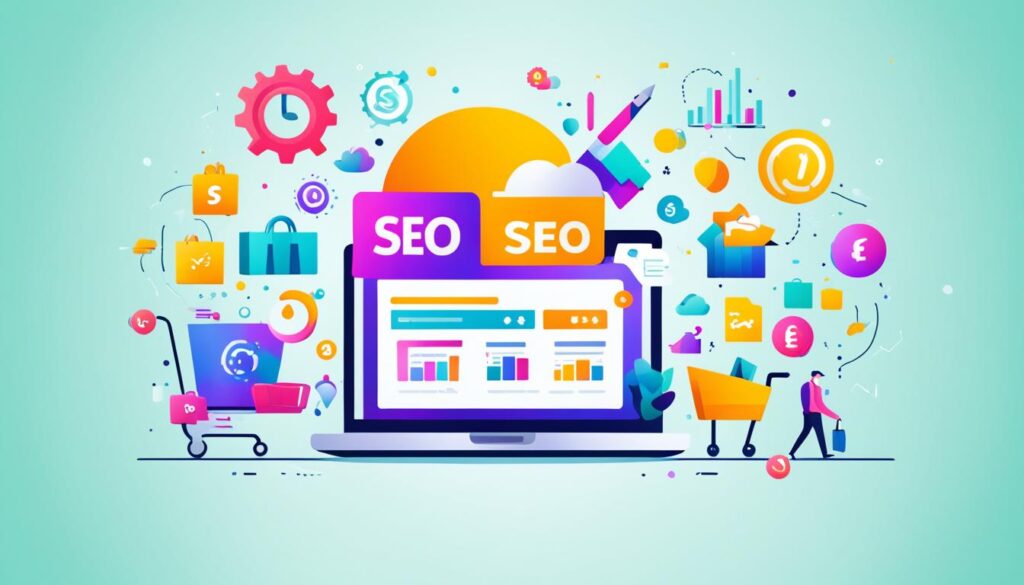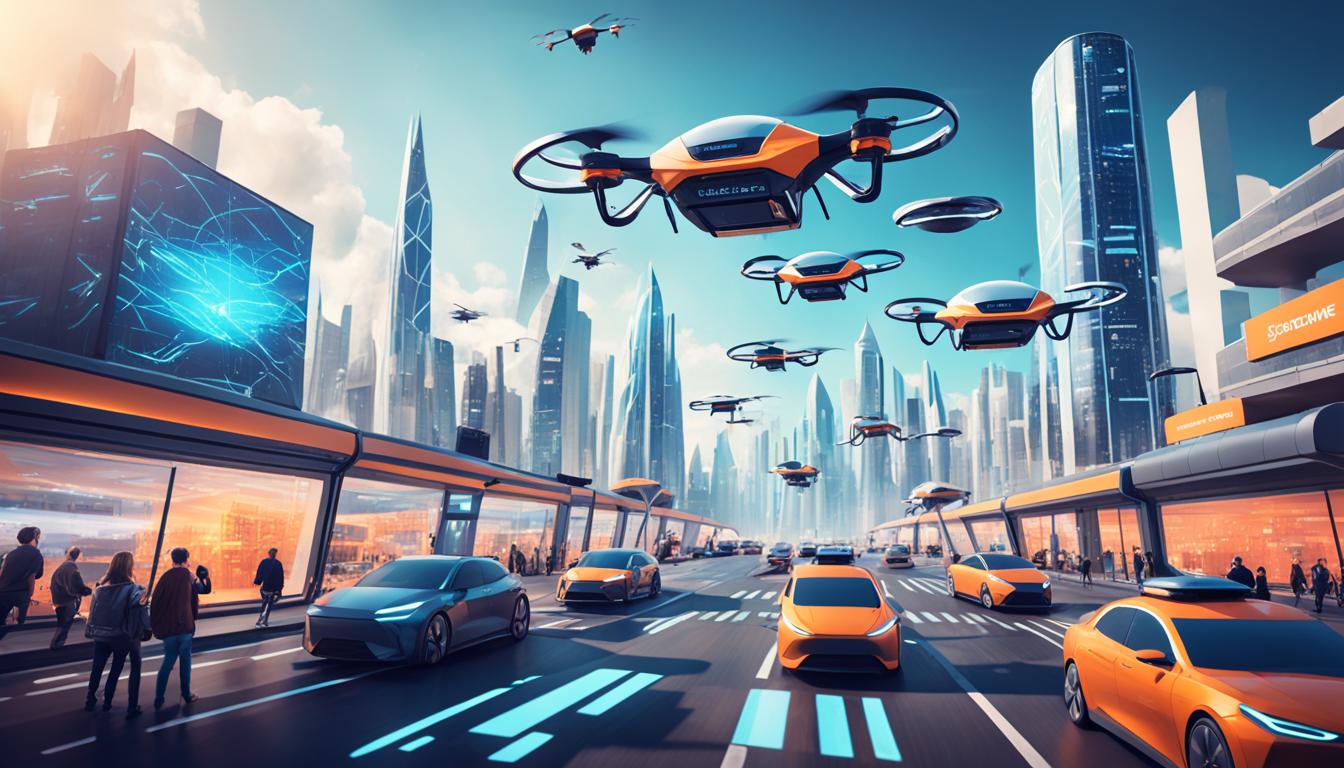Welcome to the world of e-commerce and dropshipping! As an online business owner, you know that standing out in the digital landscape is no easy feat. With numerous e-commerce stores and dropshipping businesses vying for customers’ attention, it’s crucial to have a strategic plan in place to boost your visibility and drive more sales. This is where SEO (Search Engine Optimization) comes into play.
SEO is the key to unlocking the potential of your e-commerce store or dropshipping website. By optimizing your online store for search engines, you can skyrocket your rankings, attract more organic traffic, and ultimately increase your revenue. Whether you’re a seasoned e-commerce entrepreneur or just starting out on your online entrepreneurship journey, mastering the art of SEO is essential for success in this fast-paced, competitive industry.
Key Takeaways:
- SEO is crucial for e-commerce and dropshipping businesses to increase visibility and boost sales.
- Understanding the basics of e-commerce and dropshipping is essential in optimizing your online store.
- Optimizing your e-commerce store and dropshipping website with SEO strategies can significantly improve your rankings.
- Social media and content marketing are powerful tools for driving organic traffic to your online business.
- Mastering technical SEO and implementing off-page SEO strategies are key to long-term success.
Understanding the Basics of E-commerce and Dropshipping
Whether you’re an aspiring entrepreneur or an established business owner looking to expand your online presence, understanding the fundamentals of e-commerce and dropshipping is essential. These business models offer lucrative opportunities for growth and success in the ever-evolving world of online business.
E-commerce refers to the buying and selling of goods and services over the internet, while dropshipping is a fulfillment method where the retailer does not keep products in stock. Instead, products are purchased from a third-party supplier and shipped directly to the customer. By leveraging these models, entrepreneurs can establish profitable online stores without the burden of inventory management or excessive upfront costs.
One of the key advantages of e-commerce and dropshipping is the accessibility it provides to aspiring business owners. With minimal financial investment and a robust online platform, individuals can start selling products to customers worldwide within a short period. This scalability makes e-commerce and dropshipping an attractive choice for entrepreneurs seeking to tap into the vast online marketplace.
“E-commerce and dropshipping offer tremendous opportunities for entrepreneurs to expand their online businesses without the traditional limitations associated with inventory management.”
Understanding the differences between e-commerce and dropshipping is crucial for effectively implementing the right strategies and maximizing success. While e-commerce allows businesses to sell a wide range of products directly to customers, dropshipping introduces a unique supply chain dynamic where retailers act as intermediaries between suppliers and consumers.
In the next section, we will explore the essential strategies to optimize your e-commerce store effectively. From keyword research to site structure, we will delve into the critical aspects that will help you enhance your online business and outshine the competition.
Optimizing Your E-commerce Store
When it comes to running a successful e-commerce store, optimizing your website for search engines is a vital step. Implementing effective SEO strategies will not only improve your website’s visibility in search results but also drive more organic traffic and increase conversions. In this section, we will explore the essential SEO techniques that will help you optimize your e-commerce store and boost its performance.
Keyword Research
One of the first steps in optimizing your e-commerce store is conducting thorough keyword research. By identifying the keywords and phrases your target audience is searching for, you can tailor your website content to match their intentions and improve your chances of ranking higher in search engine results pages. Use keyword research tools like Google Keyword Planner, SEMrush, or Ahrefs to identify relevant and high-performing keywords for your e-commerce store.
On-Page Optimization
On-page optimization involves optimizing individual webpages to improve their visibility and relevance to search engines. Some key on-page optimization techniques for your e-commerce store include:
- Optimizing Meta Tags: Craft compelling meta titles and descriptions for each webpage, incorporating relevant keywords to entice users to click through to your website.
- Optimizing Headings: Use H1, H2, and H3 tags appropriately to structure your webpage content and make it more readable and scannable for both users and search engines.
- Optimizing URL Structure: Create SEO-friendly URLs that are concise, descriptive, and include relevant keywords.
- Optimizing Image Alt Tags: Use descriptive alt tags for your product images to improve their visibility in image searches and provide alternative text for visually impaired users.
Site Structure and Navigation
Having a well-organized site structure and intuitive navigation is crucial for both users and search engines. A clear and logical site structure allows search engines to crawl and index your webpages more effectively, improving your chances of ranking higher in search results. Additionally, a user-friendly navigation system ensures that visitors can easily find what they’re looking for, leading to a better user experience and increased conversions. Consider the following tips for optimizing site structure and navigation:
- Group your products into relevant categories and subcategories, creating a hierarchical structure.
- Ensure that your website has a clear and consistent navigation menu that is easy to understand and use.
- Include internal links between related product pages or categories to help users and search engines navigate through your website more effectively.
Remember, a well-optimized e-commerce store is more likely to attract and engage customers, resulting in higher sales and business success. Take the time to implement these SEO strategies and set yourself apart from the competition.
“By optimizing your e-commerce store, you can enhance its visibility in search engine results and attract more customers.” – Shopify
| Benefits of Optimizing Your E-commerce Store | Factors to Consider |
|---|---|
| Improved search engine visibility | Keyword research |
| Increased organic traffic | On-page optimization |
| Higher rankings in search results | Site structure and navigation |
| Better user experience | |
| Increased conversions and sales |
Enhancing Dropshipping Business with SEO
When it comes to dropshipping, implementing effective SEO strategies can significantly enhance your online presence and boost your business. In this section, we will explore specific tactics and strategies that you can implement to optimize your dropshipping store and website, ultimately driving more traffic and increasing sales.
Product Research
One of the key factors in running a successful dropshipping business is selecting the right products to sell. Conducting thorough product research can help you identify high-demand items that align with your target audience’s needs and interests. By utilizing keyword research tools and analyzing market trends, you can uncover profitable niches and find products that have the potential to perform well in search engine rankings.
Supplier Selection
Choosing reliable and reputable suppliers is essential for maintaining a positive customer experience. When selecting suppliers for your dropshipping business, consider factors such as product quality, shipping times, and customer feedback. Opting for trusted suppliers who offer competitive pricing and efficient shipping can improve customer satisfaction and help you establish a trustworthy reputation.
Optimizing Product Listings
Well-optimized product listings are crucial for attracting organic traffic and increasing conversions. When creating your product listings, make sure to incorporate relevant keywords in your titles, descriptions, and meta tags. Use compelling and informative product descriptions that highlight the unique selling points of your items. Additionally, optimize your product images by adding alt tags that include keywords related to your products and target audience.
| Benefits of SEO for Dropshipping Business | How to Enhance Your Dropshipping Business with SEO |
|---|---|
| Increased online visibility | Thorough product research to find profitable niches |
| Higher search engine rankings | Selecting reliable suppliers for quality products |
| Improved customer trust and credibility | Optimizing product listings with relevant keywords |
| Organic traffic growth | Utilizing effective link building strategies |
| Increased conversion rates | Creating engaging and shareable content |
By implementing these SEO strategies in your dropshipping business, you can improve your online visibility, attract more organic traffic, and increase sales. It’s important to consistently monitor and analyze the performance of your SEO efforts to identify areas for improvement and stay ahead in the competitive dropshipping industry.
Leveraging Social Media and Content Marketing for E-commerce SEO
Social media and content marketing are powerful tools that can significantly impact the search engine optimization (SEO) efforts of your e-commerce business. By creating compelling content and utilizing popular social media platforms, you can drive organic traffic and enhance your online visibility. In this section, we will explore how to leverage social media and content marketing to boost your e-commerce SEO.
Creating Engaging Content
Content is king when it comes to SEO, and e-commerce businesses are no exception. To attract and retain customers, you need to create high-quality, informative, and engaging content that speaks directly to your target audience. Consider the following content strategies:
- Create informative blog posts and articles related to your products or industry. Use relevant keywords naturally in your content.
- Produce engaging product descriptions that highlight the benefits and features of your offerings. Optimize them for SEO.
- Develop visually appealing and shareable infographics that provide valuable information in a concise format.
Remember to focus on quality rather than quantity. Create content that provides value and addresses the needs and interests of your target audience.
Leveraging Social Media Platforms
Social media platforms offer immense opportunities for businesses to connect with their audience, increase brand awareness, and drive traffic to their e-commerce websites. Each platform has its unique strengths, and it’s crucial to understand how to make the most of them:
- Facebook: Create a business page and regularly share engaging posts, including product updates, promotions, and relevant content. Drive traffic to your website by using Facebook’s advertising platform.
- Instagram: Share visually appealing images and videos of your products. Utilize hashtags relevant to your niche to expand your reach and engage with your target audience.
- Twitter: Share bite-sized updates, industry news, and promotions. Use trending hashtags and engage in conversations to increase visibility.
Driving Organic Traffic
In addition to creating compelling content and utilizing social media, there are other strategies you can employ to drive organic traffic to your e-commerce store:
- Optimize your website: Ensure that your website is SEO-friendly by optimizing meta tags, URLs, and headings. Improve site speed and mobile responsiveness to provide a seamless user experience.
- Implement email marketing: Build an email list and regularly send out newsletters and promotional campaigns to engage with your audience and drive traffic to your website.
- Guest blogging: Write informative articles for popular blogs in your niche to gain exposure and generate backlinks to your e-commerce website.
Image for Reference:

By effectively leveraging social media and content marketing, you can boost your e-commerce SEO efforts and enhance your online presence. Remember to consistently create valuable content, engage with your audience on social media, and implement strategies to drive organic traffic to your website.
Mastering Technical SEO for E-commerce and Dropshipping Websites
When it comes to building a successful e-commerce or dropshipping website, technical SEO plays a crucial role in ensuring that your online store is search engine friendly. By optimizing various technical aspects, you can improve your website’s visibility, organic rankings, and overall performance. In this section, we will delve into the key technical SEO elements that you should master to maximize your website’s potential and drive more traffic to your e-commerce or dropshipping store.
1. Site Speed Optimization
One of the most critical factors for both user experience and SEO is site speed. A slow-loading website can lead to higher bounce rates and lower search engine rankings. To enhance your site’s speed:
- Optimize image file sizes without compromising quality.
- Minimize HTTP requests and combine CSS and JavaScript files.
- Utilize browser caching and CDNs (Content Delivery Networks).
| Website Speed Optimization Techniques | Benefits |
|---|---|
| Compressing Images | Reduces page load time |
| Minifying CSS and JavaScript | Reduces file size and improves load speed |
| Leveraging Browser Caching | Reduces server requests and improves load speed |
2. Mobile Responsiveness
In today’s mobile-dominated era, having a mobile-responsive website is essential. Search engines prioritize mobile-friendly websites in their rankings. Ensure that your website:
- Has a responsive design that adapts to different screen sizes.
- Uses a mobile-friendly theme or template.
- Avoids intrusive pop-ups that hamper user experience on mobile devices.
3. Structured Data Markup
Implementing structured data markup can help search engines understand the content and context of your e-commerce or dropshipping website better. This, in turn, can lead to enhanced search visibility and the display of rich snippets in search results. Common structured data markup formats include JSON-LD and Microdata.
“Structured data provides search engines with clearer insights into your website’s content, resulting in improved visibility and increased click-through rates.”
4. URL Structure
An optimized URL structure not only makes it easier for users to navigate your website but also helps search engines crawl and understand your site’s pages. Consider the following best practices:
- Use descriptive, short, and keyword-rich URLs.
- Avoid using dynamic parameters and unnecessary characters.
- Utilize hyphens to separate words in the URL for better readability.
With these technical SEO strategies, you can lay a solid foundation for your e-commerce or dropshipping website’s success. The next section will explore off-page SEO strategies, which will further amplify your online presence and drive more targeted traffic to your store.
Off-page SEO Strategies for E-commerce and Dropshipping Success
Building high-quality backlinks and establishing a strong online presence are vital for the success of your e-commerce and dropshipping business. While optimizing your website is crucial, off-page SEO strategies play a significant role in enhancing your online visibility and driving organic traffic. In this section, we will dive into effective off-page SEO techniques specifically tailored for e-commerce and dropshipping businesses.
Influencer Marketing
Leveraging the power of influencers can significantly boost your brand’s reach and credibility. Identify influencers within your industry or niche who have a substantial online following and engage with them to promote your products or services. Collaborating with influencers can not only increase brand awareness but also drive targeted traffic to your e-commerce store or dropshipping website.
Link Building
Link building remains one of the key elements of off-page SEO. Focus on acquiring high-quality backlinks from authoritative websites that are relevant to your industry. These backlinks act as a vote of confidence for search engines and can improve your website’s visibility and rankings. Consider guest blogging, influencer collaborations, and reaching out to industry influencers to earn valuable backlinks.
Online Reputation Management
Managing your online reputation is crucial in building trust and credibility for your e-commerce or dropshipping business. Monitor and respond to customer reviews and feedback promptly. Encourage satisfied customers to leave positive reviews on review platforms or social media, as this can enhance your online reputation and attract potential customers. Additionally, utilize social listening tools to monitor brand mentions and address any negative sentiment promptly.
Social Media Engagement
Social media platforms offer excellent opportunities to engage with your target audience and promote your e-commerce or dropshipping business. Create compelling content that resonates with your audience and encourages social media shares. Actively participate in industry-related conversations, respond to customer inquiries and comments, and leverage social media influencers to amplify your brand’s reach.
Online Partnerships
Collaborating with complementary businesses or influencers in your industry can help expand your reach and attract a broader audience. Consider forming partnerships for cross-promotion, joint marketing campaigns, or affiliate programs. These online partnerships can introduce your brand to new customers and generate valuable referral traffic to your e-commerce store or dropshipping website.
Implementing these off-page SEO strategies can supercharge the success of your e-commerce and dropshipping business, helping you establish a strong online presence, increase brand visibility, and drive organic traffic. By combining these techniques with effective on-page optimization, you can maximize your chances of ranking higher in search engine results and ultimately boost your sales and revenue.
Table: Comparison of Off-page SEO Strategies
| Off-page SEO Strategy | Benefits | Examples |
|---|---|---|
| Influencer Marketing | Increased brand awareness and credibility | Collaborating with industry influencers to promote your products |
| Link Building | Improved website visibility and rankings | Acquiring backlinks from authoritative websites |
| Online Reputation Management | Enhanced trust and positive brand image | Monitoring and addressing customer reviews and feedback |
| Social Media Engagement | Increased brand reach and audience engagement | Creating compelling content and actively participating in industry-related conversations |
| Online Partnerships | Expanded reach and referral traffic | Collaborating with complementary businesses for cross-promotion or affiliate programs |

Implementing effective off-page SEO strategies can significantly impact the success of your e-commerce or dropshipping business, expanding your reach, and driving organic traffic. By diversifying your approach and leveraging key tactics such as influencer marketing, link building, online reputation management, social media engagement, and online partnerships, you can establish a strong online presence and maximize your chances of success in the competitive world of online entrepreneurship.
Conclusion
Implementing effective SEO strategies is crucial for maximizing your visibility, rankings, and sales in the fiercely competitive e-commerce and dropshipping landscape. By following the guidelines outlined in this article, you can take your online store to new heights and achieve long-term success.
First and foremost, optimizing your e-commerce store is essential. Conduct thorough keyword research, ensure your site has proper on-page optimization, and create a user-friendly site structure. These steps will help search engines understand your store’s content and improve your rankings.
In addition, don’t overlook the importance of enhancing your dropshipping business with SEO. Take the time to conduct product research and carefully select suppliers. Optimize your product listings with relevant keywords and compelling descriptions, making it easier for customers to find and engage with your products.
To ensure your e-commerce SEO efforts reach a broader audience, leverage the power of social media and content marketing. Create valuable and shareable content that resonates with your target audience across various platforms, driving organic traffic and increasing brand visibility.
Lastly, mastering the technical aspects of SEO is crucial for success. Pay attention to factors such as site speed optimization, mobile responsiveness, structured data, and URL structure. These technical SEO elements improve user experience and help search engines crawl and index your website effectively.
Remember, off-page SEO strategies play a vital role in establishing your online presence. Build high-quality backlinks through link building and influencer marketing. And don’t forget the value of online reputation management to maintain a positive image and credibility among your audience.
By implementing these strategies and investing in effective SEO practices, you can position your e-commerce or dropshipping business for long-term success, outrank competitors, and drive substantial sales. Stay consistent, monitor your progress, and adapt to changing algorithms and trends to maintain your SEO advantage.
FAQ
What is dropshipping?
Dropshipping is a business model where an online store owner doesn’t keep the products it sells in stock. Instead, when a store owner sells a product using the dropshipping model, they purchase the item from a third party and have it shipped directly to the customer. As a result, the store owner never sees or handles the product.
How do I start an e-commerce store?
Starting an e-commerce store involves several steps. First, you need to decide on the products or services you want to sell and identify your target market. Then, you’ll need to choose an e-commerce platform, set up your website, and customize it to reflect your brand. Additionally, you’ll need to secure reliable suppliers, optimize your product listings, and implement marketing strategies to drive traffic and sales to your online store.
Can I run a dropshipping business with limited capital?
Yes, one of the advantages of dropshipping is that you can start and run a business with limited capital. Since you don’t need to invest in inventory upfront, you can focus on building your online store, marketing your products, and driving sales. As orders come in, you can then purchase products from your suppliers to fulfill customer orders.
How can I drive traffic to my e-commerce website?
There are various strategies you can implement to drive traffic to your e-commerce website. Some effective methods include search engine optimization (SEO), social media marketing, content marketing, email marketing, influencer partnerships, and paid advertising. By implementing a combination of these strategies, you can increase your website’s visibility and attract potential customers.
Are there any advantages to using dropshipping for my online business?
Yes, dropshipping offers several advantages for online business owners. Firstly, it allows you to start a business with minimal upfront costs since you don’t need to invest in inventory. It also eliminates the need for warehousing and shipping logistics, as suppliers handle those aspects. Additionally, dropshipping allows for greater flexibility, as you can test new products and niches without the risk of being stuck with unsold inventory.
How can I optimize my e-commerce store for better SEO rankings?
To optimize your e-commerce store for better SEO rankings, you should start by conducting keyword research to identify relevant keywords for your products and target audience. Then, optimize your product titles, descriptions, meta tags, and URLs with those keywords. It’s also important to focus on improving your website’s loading speed, user experience, and mobile responsiveness. Additionally, user-generated content and customer reviews can also enhance your store’s SEO performance.
How can I choose reliable suppliers for my dropshipping business?
When selecting suppliers for your dropshipping business, it’s crucial to choose those who can offer quality products, reliable shipping services, and competitive prices. You can research potential suppliers through online directories, industry-specific platforms, and trade shows. It’s also recommended to communicate directly with potential suppliers, ask for samples, and read customer reviews or testimonials to ensure their reliability and compatibility with your business goals.
Is content marketing important for e-commerce SEO?
Yes, content marketing is essential for e-commerce SEO. Creating and sharing valuable, informative content helps attract and engage potential customers. By publishing blog posts, product guides, tutorials, and other relevant content, you can establish your brand as an authority in your industry. Content marketing also helps drive organic traffic to your e-commerce store and increases the likelihood of acquiring quality backlinks, which contributes to better SEO rankings.
What are the key components of technical SEO for e-commerce websites?
Technical SEO for e-commerce websites involves optimizing various technical aspects to ensure search engines can crawl, index, and understand your site. Key components include optimizing your website’s site speed, improving mobile responsiveness, implementing structured data markup, optimizing URL structure, ensuring proper canonical tags, and creating XML sitemaps. These technical optimizations help search engines interpret and rank your web pages effectively.
How can I build high-quality backlinks for my e-commerce or dropshipping store?
Building high-quality backlinks for your e-commerce or dropshipping store is crucial for improving your online visibility and SEO rankings. Some strategies to consider include reaching out to relevant bloggers or influencers for guest posting opportunities, creating compelling infographics or data-driven content that others will want to link to, and collaborating with industry partners for co-marketing campaigns. It’s important to focus on acquiring backlinks from authoritative and relevant websites to maximize their impact on your store’s SEO.
What are some effective off-page SEO strategies for e-commerce and dropshipping success?
Off-page SEO strategies for e-commerce and dropshipping success include building high-quality backlinks, engaging in influencer marketing, leveraging social media platforms, managing online reputation, and seeking customer reviews or testimonials. These strategies help improve your brand’s visibility, credibility, and online presence, leading to increased organic traffic and sales. It’s important to develop a comprehensive off-page SEO plan that aligns with your business goals and target audience.







